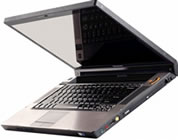See our latest update: TechSpot PC Buying Guide
It's been six months since our last laptop buying guide update and while the scene has changed a bit, we're still waiting on the inevitable implementation of Intel's Core i7 in notebooks through the course of 2009. Regardless of what's to come, the Core 2 Duo is still holding strong and probably will for a while, so now is as good of a time as any to make a notebook purchase.
In a similar fashion to the last guide, we will attempt to cover the ideal specifications for a few popular price points and system varieties. The most obvious addition is a section dedicated to netbooks, which have been able to create a segment of their own, moving further away from the more expensive ultra-portables.
Desktop Replacement
Most would agree that attempting to replace a fully equipped desktop system is nearly impossible for a laptop to pull off. However, if you analyze the specific needs of a given desktop user, some sacrifices can usually be made, and in certain cases the possibility of moving your data around and using a docking station at the office or at home results in an equally satisfactory experience.
It's also a good thing that the pinnacle of modern notebook hardware isn't far off from what you'd find in a typical high-end desktop (processor, memory, etc.). Unfortunately, if you're going to make an attempt at replacing your mid to high-end desktop system with a mobile device, you can expect to pay for it.
|
Component
|
Desktop Replacement / Gaming Basic
|
Desktop Replacement / Gaming Advanced
|
| Processor: | Intel Core 2 Duo P8700/T9300 2.5GHz | Intel Core 2 Duo T9600 2.8GHz or better |
| RAM: | 2GB - 4GB DDR2 667MHz/800MHz | 3GB - 4GB DDR2 800MHz/1066MHz |
| Video: | Nvidia 9500M GS / 9600M GT | Nvidia 9800M GT / ATI Mobility Radeon HD 4850 or better |
| Audio: | Integrated audio with microphone and line input/output support | |
| HDD: | 250GB 7200RPM SATA | 320GB+ 7200RPM SATA / optional secondary HDD |
| Optical: | Internal DVD+/-RW | Internal DVD+/-RW / Blu-ray optional |
| Network: | Integrated 10/100/1000 Ethernet | |
| Wireless: | Internal 802.11 g/n and Bluetooth | |
| Display: | 15" - 17" | 15" - 17"+ LED backlit panel* |
| Battery: | 6 - 9 Cell Lithium Ion | 6 - 12 Cell Lithium Ion |
|
Interfaces you may require: |
Express Card slot, 4+ USB 2.0 ports, IEEE 1394 port(s), DVI/HDMI/VGA/S-Video port(s), Cable lock slot, Docking station support, Media bay | |
*As market availability permits - not all manufacturers offer LED backlit panels of 15" and up.
We recommend the P8700 or the T9300 be the absolute minimum for any serious desktop replacement system. Between the two, I'd opt for the P8700's slightly higher clock, FSB, 10W less power consumption and lower cost over the T9300's additional 3MB cache - but the differences probably aren't worth debating over on your end. To max the system out with a realistic total cost I'd probably aim no higher than a T9600 but if you actually have the coin and motivation to select a Core 2 Quad, by all means, go for it (expect to pay an additional $275-$1,000 for a quad core model).
You can probably get by just fine with 2GB of RAM but memory is so cheap today you're better off just aiming for 3GB on a 32-bit OS and 4GB on a 64-bit OS. DDR3 won't offer any real speed advantages but if that's what is included on the package, it doesn't have any drawbacks besides price either.
Dedicated graphics is an absolute must for this category and if you'll be doing anything performance intensive, it's best to focus additional funds here for something in the vicinity of an Nvidia 9800M GT or better, otherwise an Nvidia 9500M GT or similar will probably fair just fine.
Assuming this desktop replacement system will be used for anything media related, as most are, you'll want to select a 7200RPM HDD with at least a 320GB capacity.
